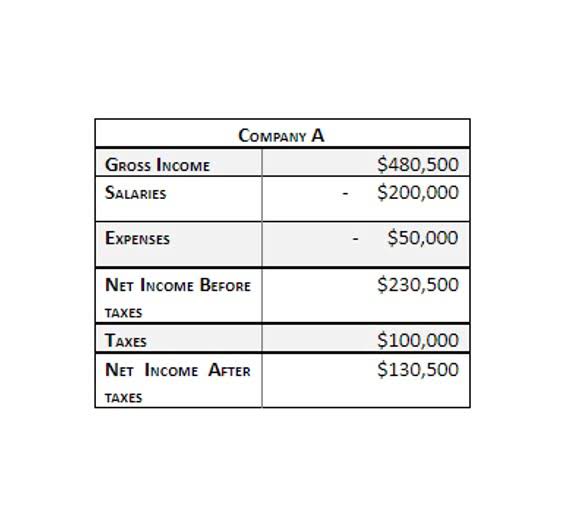
Your business might still need to report https://www.bookstime.com/ interest income, ordinary dividends, or other business income from the prior year, even with minimal activity. Explore strategies like offsetting losses against gains or utilizing available deductions and credits effectively. If you’re a partner in a partnership that is required to file a tax return for the year, then you will receive a K-1 that lists your portion of the partnership reportable items.
Step 2: Enter the Information on Your Tax Return

If your MAGI is $100,000 or less ($50,000 or less if married filing separately), your loss is deductible up to the maximum special allowance referred to in the preceding paragraph. If your MAGI is more than $100,000 (more than $50,000 if married filing separately), the special allowance is limited to 50% of the difference between $150,000 ($75,000 if married filing separately) and your MAGI. When MAGI is $150,000 or more ($75,000 or more if married filing separately), there is no special allowance. An estate is a qualifying estate if the decedent would have satisfied the active participation requirement for the activity for the tax year the decedent died. A qualifying estate is treated as actively participating for tax years ending less than 2 years after the date of the decedent’s death.
- However, if the box in item D is checked, report the loss following the rules for PTPs under Publicly traded partnerships, earlier.
- If you are a partner in a partnership, shareholder in an S corporation, or beneficiary of an estate or trust, you may receive a K-1 form.
- The K-1 form reports each partner’s share of the partnership’s financial activity.
- For example, if a partnership earns $100,000 in net income and has four equal partners, each partner would receive a K-1 form showing $25,000 as their share of the income, which is then subject to their individual tax rate.
- See the Instructions for Schedule D (Form 1040) and the Instructions for Form 8949 for details on how to report the gain and the amount of the allowable postponed gain.
Is K-1 income subject to self-employment tax?
- Assume, for example, that a partner contributes $50,000 in cash and $30,000 in equipment to a partnership, and the partner’s share of income is $10,000 for the year.
- The Tax Cuts and Jobs Act of 2017 introduced changes, including the elimination of personal exemptions and adjustments to tax brackets for estates and trusts.
- Similar to a partnership, S corporations (or S corps) file an annual tax return using Form 1120S.
- You may be treated as actively participating if you participated, for example, in making management decisions or arranging for others to provide services (such as repairs) in a significant and bona fide sense.
- A nominee who fails to furnish all the information required by Temporary Regulations section 1.6031(c)-1T when due, or who furnishes incorrect information, is subject to a $330 penalty for each failure.
- Form W-2 is used to report wages paid to employees and the taxes withheld from them.
For example, Line 1 reports ordinary business income, a figure that must be included on personal tax returns. The IRS offers detailed instructions for each line to help taxpayers accurately interpret and report these figures. Understanding your tax liability involves accurately reporting capital gains, partnership income, deductions, and more.
Opting out of partnership election.
Understanding Schedule K-1 is essential for any business or individual involved in a partnership or LLC. This form is key to ensuring accurate tax reporting for both the business and its partners. By carefully reviewing each box and understanding its impact on your tax return, you can avoid costly mistakes and take advantage k1 form meaning of available deductions and credits. Schedule K-1 is an IRS form used by partnerships, S corporations, and estates and trusts to declare the income, deductions, and credits that partners, shareholders, and beneficiaries have received in the tax year. Each partner gets their share of income reported on this tax document.


All of this helps determine how much taxable income you must report on your individual tax return. The Schedule K-1 categorizes income and deductions, each with distinct tax implications. Understanding these categories is essential for accurate reporting on your tax return. Grasping how to read and report a K-1 correctly ensures compliance with tax regulations and optimizes financial outcomes.
One can submit the documents electronically or through a qualified accountant. Schedule K-1 reports each partner or shareholder’s profits, credits, and deductions in an entity to the Internal revenue service (IRS). In the case of a business that functions as a partnership, the partners should pay the taxes on behalf of the company.
Why did I receive a Form K-1?
- Distributions reduce the capital account balance, while additional contributions increase it.
- If you materially participated in the reforestation activity, report the deduction in Schedule E (Form 1040), line 28, column (i).
- Join our exclusive monthly newsletter to receive expert insights, industry trends, valuable tips, and special offers straight to your inbox.
- The amounts reported reflect your distributive share of the partnership’s UBIA of qualified property of each qualified trade, business, or aggregation.
- A nominee that fails to furnish this statement must furnish to the person for whom the nominee holds the partnership interest a copy of Schedule K-1 and related information within 30 days of receiving it from the partnership.
- If your organization is an S corporation, you’ll use Form 1120-S to report each S corp shareholder’s percentage of income, losses, and deductions.
For example, ordinary business income is taxed at the individual’s marginal tax rate, while qualified dividends and long-term capital gains benefit from lower rates of 0%, 15%, or 20%, depending on income levels. If a partner receives $10,000 in ordinary income and $5,000 in qualified dividends, each category is taxed accordingly. And remember, if you receive a final K-1, you still have to report that on your individual tax return, even if you’re no longer a partner when the tax return is filed. If you got cash or property when exiting, that’s likely a distribution—and may trigger capital gains if it exceeds your basis, affecting your overall tax due.
IRS.COM is a non-government website designed to help taxpayers find accurate, easy-to-understand tax information, valuable tax products, and tax-related services. As of tax years beginning in 2021, pass-through entities with items of international tax relevance must complete the new schedules. In general, the Form 1065 Schedule K-3 reports a partner’s distributive share of items of international tax relevance and is an extension of the Form 1065 Schedule K-1. A Schedule K-1 lists taxable income, similar to a W2 or a Form 1099, but only for the particular types of business entities outlined above. A partnership is defined as a contract between adjusting entries two or more people who decide to work together as partners.
Reasons One Would Receive a Schedule K-1 Form
If you believe you are owed a Form K-1 but have not received it, you should contact the issuing entity promptly. A partner is required to notify the partnership of its status as a PTP. The partnership will give you a description and the amount of your share for each of these items. Code N. Gain eligible for section 1045 rollover (replacement stock not purchased by the partnership). Code M. Gain eligible for section 1045 rollover (replacement stock purchased by partnership).
